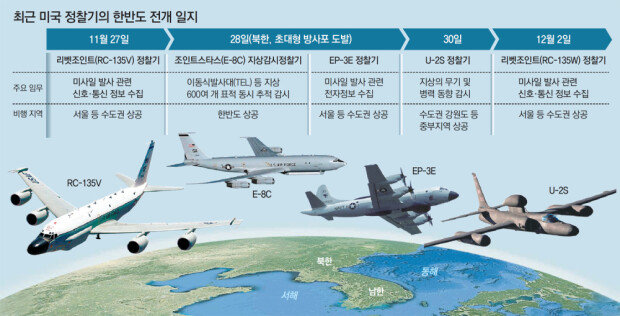U.S. reconnaissance plane flies over Korean Peninsula
U.S. reconnaissance plane flies over Korean Peninsula
Posted December. 03, 2019 07:15,
Updated December. 03, 2019 07:15

A U.S. reconnaissance plane on an apparent mission to monitor North Korea was spotted flying above the Korean Peninsula, according to an aviation tracker, fueling speculation that the North could take on additional military provocations. With Pyongyang also known to have installed more concrete pads for missile launches using transporter erector launchers (TEL), tensions have ratcheted up over the Korean Peninsula nearing the end of the year.
According to Aircraft Sports, a site that tracks military aircraft movements, on Monday, a plane thought to be an RC-135W Ribet Joint flew in the skies above South Korea’s capital areas. Tasked with collecting and analyzing communications and signals, the plane is known to collect data regarding the North’s preparations for missile launches across the country. The appearance of the reconnaissance plane has triggered speculation that Pyongyang is preparing for another test-launch following its test-firing of a super-large multiple rocket launcher on Thursday.
North Korea has usually chosen airfields or expressways for a site for missile launches because open fields without concrete on the surface would have weaker grounds for a test launch through TEL, raising the possibility of failure. This is why the North has been installing concrete pads on possible sites. “If North Korea randomly establishes more concrete pads, this would significantly increase the number of areas that South Korea and the United States will have to monitor, possibly causing a vacuum in the monitoring system,” said Shin Jong-woo, a senior analyst at the Korea Defense Security Forum.
Such circumstances point to a possibility that North Korea may attempt to undertake additional provocations using TEL vehicles in a move to put pressure both on Seoul and Washington before the end of the year. As North Korean leader Kim Jong Un had given an end-of-year deadline for nuclear talks, the regime seems likely to refrain from test-firing inter-continental ballistic missiles (ICBM) by the year end. Still, observers say it may make a last-minute move by launching submarine-launched ballistic missiles (SLBM) or its Hwasong-12 intermediate-range ballistic missiles (with the range of up to 5,000 kilometers).
Hyo-Ju Son hjson@donga.com
Headline News
- N. Korea launches cyberattacks on S. Korea's defense companies
- Major university hospital professors consider a day off each week
- Italy suffers from fiscal deficits from ‘Super Bonus’ scheme
- Inter Milan secures 20th Serie A title, surpassing AC Milan
- Ruling and opposition prioritize spending amid tax revenue shortfalls







